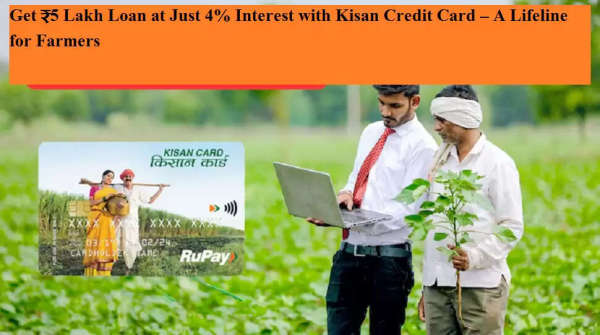
The Indian government’s Kisan Credit Card (KCC) scheme is transforming the way farmers access financial support for their agricultural needs. With a loan offering of up to ₹5 lakh at just 4% annual interest, this initiative is designed to empower millions of farmers by providing affordable, collateral-free credit for farming and allied activities. Easy to apply and integrated with digital access, the KCC has become a game-changer for India’s agricultural sector.
Launched in 1998, the Kisan Credit Card scheme was introduced to ensure that farmers receive timely and hassle-free access to credit for their crop-related and ancillary needs. Under this initiative, farmers can borrow money for expenses like buying seeds, fertilizers, farming equipment, post-harvest operations, livestock maintenance, and even household needs.
Unlike traditional loans that often involve complex paperwork and higher interest rates, the KCC offers quick loans with minimal documentation, making it especially beneficial for small and marginal farmers.
The government offers a 2% interest subsidy on KCC loans and provides an additional 3% incentive for timely repayment, effectively bringing the interest rate down to just 4% per annum. This makes it one of the most affordable credit schemes for farmers in India.
Finance Minister Nirmala Sitharaman, in the 2025 Union Budget, raised the maximum loan limit under KCC from ₹3 lakh to ₹5 lakh, significantly expanding the scope for financial inclusion in agriculture.
The KCC scheme is open to:
Individual farmers with ownership of land
Tenant farmers, sharecroppers, and oral lessees
Joint liability groups (JLGs) and self-help groups (SHGs)
The loan limit under KCC is calculated based on several factors, including:
Type and scale of crop cultivation
Cost of production
Size of landholding
Insurance and equipment maintenance needs
Loans up to ₹2 lakh are collateral-free, while higher amounts may require security as per the bank’s policy. Typically, the loan limit is reviewed annually, and it may increase by 10% each year over a five-year cycle.
The loan limit is divided into:
Short-term credit (for seasonal crops)
Term loans (for durable investments like tractors, irrigation, etc.)
This bifurcation allows banks to apply appropriate repayment conditions and interest rates for each type of loan, while farmers benefit from greater financial clarity and flexibility.
The KCC functions as a multipurpose debit card, issued by banks to eligible farmers. With it, farmers can:
Withdraw cash via ATMs or bank correspondents (Bank Mitras)
Make purchases through PoS machines at agriculture input shops
Use mobile banking or Aadhaar-authenticated systems
The card is often linked to biometric or Aadhaar-based identification, ensuring secure and quick transactions.
Online Process:
Visit the official website of the preferred bank.
Select the “Kisan Credit Card” option.
Click on “Apply.”
Fill in the required details and submit.
You’ll receive an application number, and the bank will reach out within 3–4 working days.
Offline Process:
Farmers can visit their nearest bank branch, fill out the KCC form, and submit it with the necessary documents. After verification, the bank will approve the KCC if the applicant is eligible.
Duly filled application form
Identity and address proof (Aadhaar, driving license, etc.)
Passport-size photo
Proof of land ownership
Crop pattern details
Security documents (if loan exceeds ₹1.60 lakh)
As of July 2025, there are over 7.75 crore active KCC accounts across India. The scheme has witnessed phenomenal growth, with the loan amount rising from ₹4.26 lakh crore in 2014 to ₹10.05 lakh crore in 2024. This demonstrates the increasing trust and dependence of Indian farmers on the KCC framework.
The Kisan Credit Card scheme is not just a financial product; it is a lifeline for rural India. With low interest, simple procedures, and digital integration, KCC bridges the gap between farmers and formal credit systems. For millions of cultivators struggling with rising input costs, KCC provides timely relief and boosts their journey toward self-reliance and agricultural sustainability.